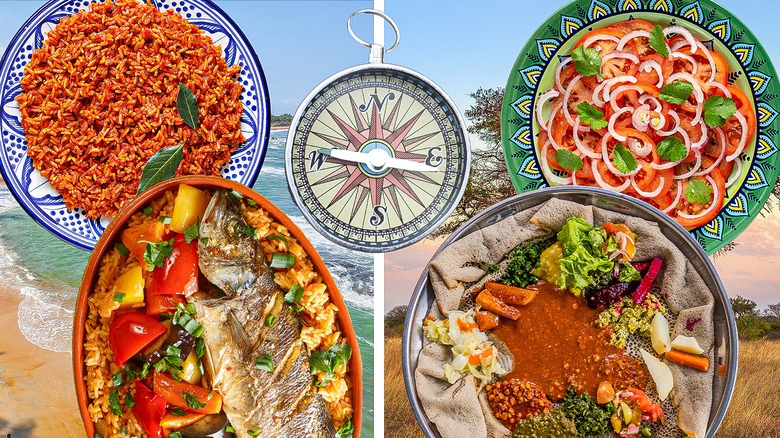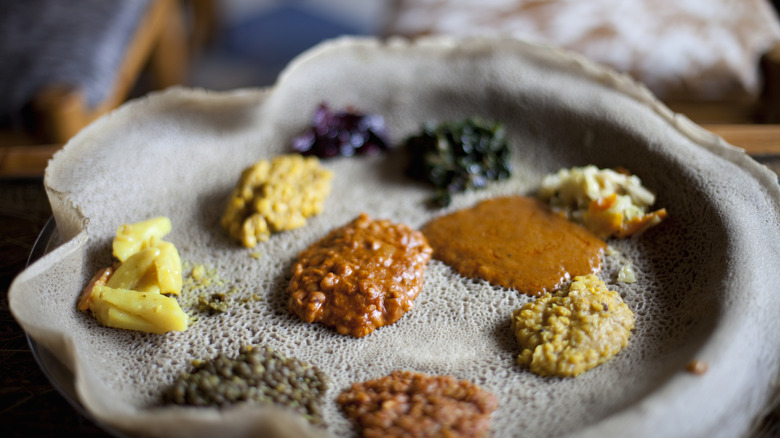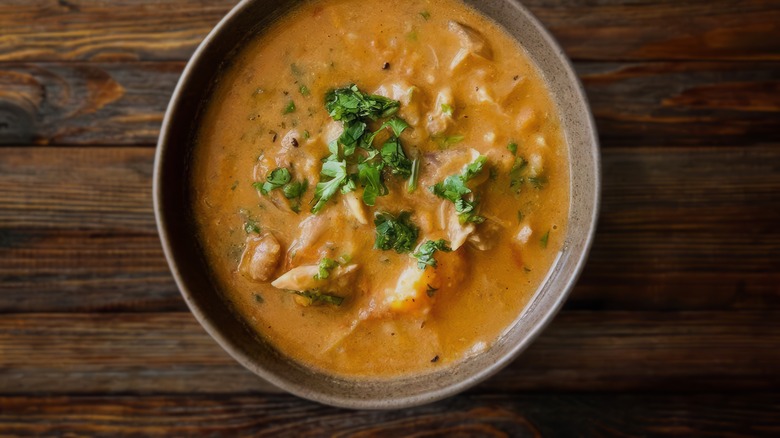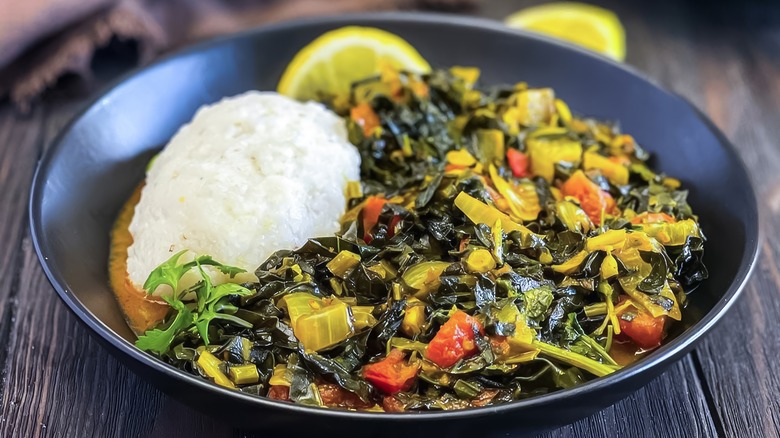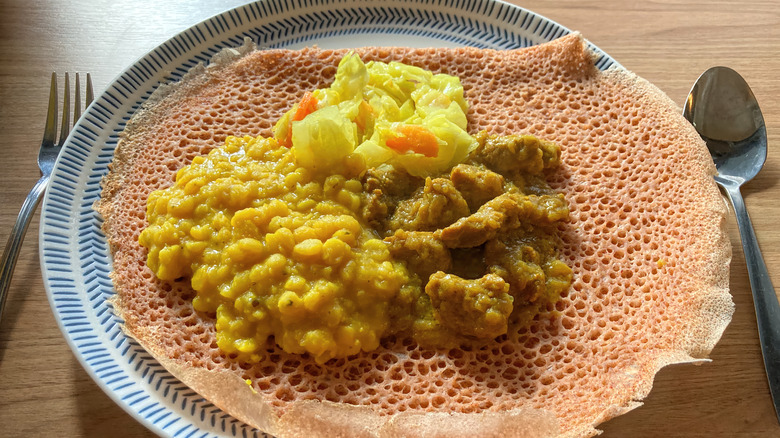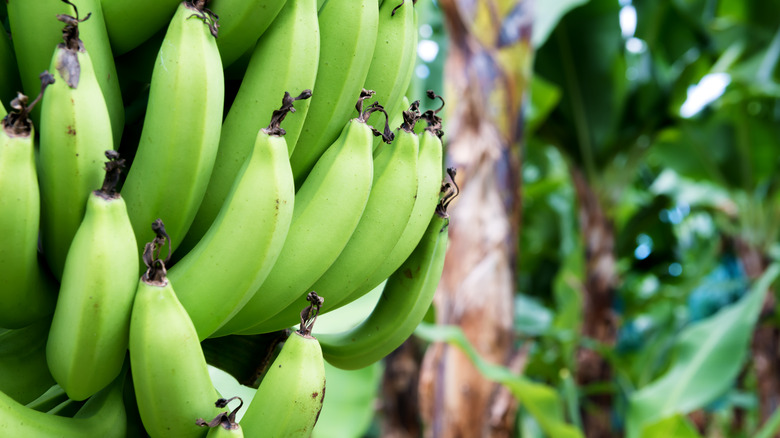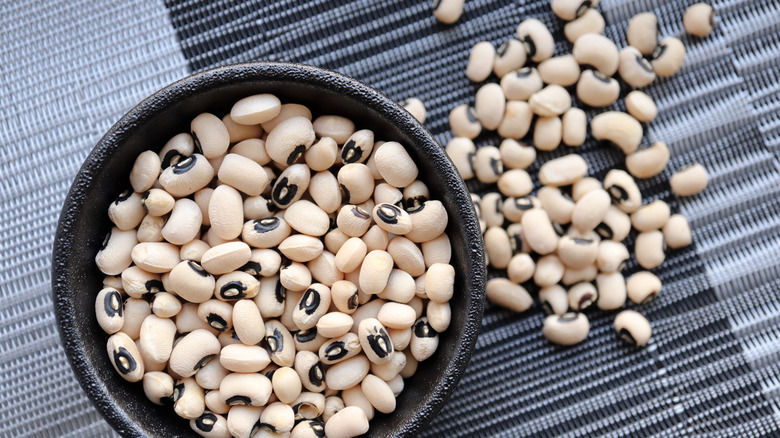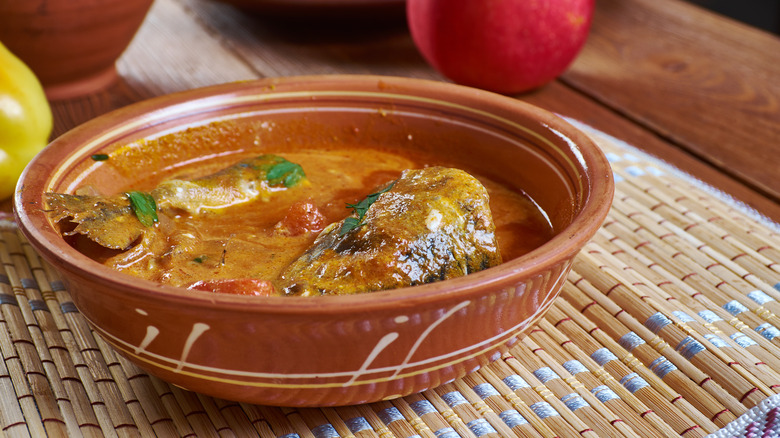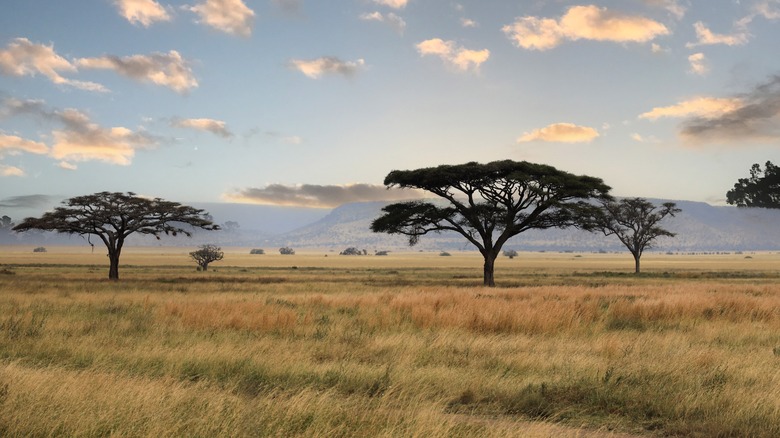East Vs West African Cuisine: What's The Difference?
For those of us deciding between macaroni and cheese or pizza for dinner, ethnic cuisine may not even be on our radar. But why live a life without exploring all that the culinary world has to offer? Each corner of our planet is filled with spices, meats, herbs, vegetables, and grains that could change your life, so it's time to get your feet wet. When exploring African cuisine you may find quite a range of culinary styles, which makes sense because Africa is a huge continent. Northern African cuisine is rich with influence from the Mediterranean and Arabic countries, while Southern Africa's cuisine harbors notes from Dutch and Indian fares. East and West African cuisine is often grouped, and while having some overlap, the two regions also contain very different styles and cultural influences. So, let's explore those differences.
As a Cultural Anthropology major with a focus on African Studies and food culture, I have dived into the world of African cuisine many times and visited the continent on three occasions. I've found that deep flavor is never absent in an East or West African dish, and you can almost taste the influence of surrounding cultures. I've also reached out to Donna Kerner, PhD, Professor of Anthropology with expertise in the study of food culture and African studies. Together, we target some of the main differences between West and East African cuisine, so you can begin to expand your culinary horizons.
What is East African cuisine?
In the most literal sense, East African cuisine is comprised of dishes that are popular in or originated from one of the countries that make up East Africa. East Africa is typically recognized as far north as Eritrea, as far south as Tanzania, and as far inland as Ghana. Each country has its own rich culture, delicacies, staple crops, and unique flavor. However, like any region, surrounding countries influence each other's culture, so there are many overlaps when it comes to popular cuisine. Much of a country's staple foods are associated with easy-to-grow, accessible, and reliable staple crops. In addition, nearby countries and continents influence the region's cuisine because of easy trade routes. Additionally, countries with a history of colonization typically have a mash-up of cultural influences, utilizing aspects of both the colonizer's culture and the native cultures of the country.
Therefore, East African cuisine has quite a bit of range but is generally very vegetable-heavy. Starchy vegetables and whole grains make up the bulk of East African fare. Legumes like beans and lentils are also popular, and the spices tend to be plentiful and bold. Meat is less frequently consumed than in many other parts of Africa, but when it is, goat, mutton, and sometimes chicken and beef are the meats of choice. East Africa is known for its stews and sauces, eaten alongside starches and breads. The popular East African dish, Ethiopian Beyainatu, is a great example of this as it has a variety of spice-rich, starchy sauces and stews eaten with crepe-like bread.
What is West African cuisine?
Like East African cuisine, West African cuisine varies from culture to culture and country to country. However, some major themes run deep in West African food. Unlike East African cuisine, West African fare tends to be meat-heavy, focusing mainly on goat and fish, with chicken close behind, along with pork. Beef is less popular due to its expensive nature. Grains like rice and fonio are popular to consume alongside the meat, as well as starchy root vegetables like taro and cassava. Stews and soups are common, especially those filled with aromatic spices, and rich tomato bases. Plant leaves don't go to waste in the West, as cassava leaves, sweet potato leaves, and black-eyed pea leaves are commonly cooked up and consumed.
West African fare has some colonial influence but is rich in native African culture, with less influence from the trade systems outside of the continent. Perhaps this is because this Western cluster of countries is more isolated than East Africa, which is in closer proximity to other cultures. There are endless West African dishes you need to try at least once in your life, most accompanied by an ancient grain including teff, fonio, and maze. Fufu is another staple, which is essentially a large sticky ball made of starchy root vegetables and grains to be eaten alongside meat, vegetables, and stews. It's also a favorite of Professor Kerner's.
Their staple starches vary
Both West and East African fare is loaded with starches. These are mainly starchy vegetables, mostly roots, and grains. These starches are eaten as a side or used as a vehicle to eat the main parts of a meal which is typically made of meat or vegetables. These meat and vegetable dishes are spiced and sauced up, so the starches help to distribute some of that flavor, and absorb the sauces. This is a practice used all around the world. Both East and West Africa use tarro root, cassava root, and maize. A mashed ball of starchy goodness is popular alongside main courses, called fufu in West Africa and ugali in East Africa.
While rice and fonio (a grain you should pay attention to) are more heavily consumed in West Africa, East Africa has a heavier focus on green bananas and plantains. Professor Kerner points out that "the horn of Africa (Ethiopia/Eritrea) is an exception in that it relies primarily on the grain teff," an edible grass seed. West Africans consume starchy roots, as they grow easily in the climate and terrain. Eating millet, yams, sweet potatoes, and legumes is a quick way to load up on carbohydrates for energy and they are plentiful in the West. While corn is popular across the continent, East Africans tend to rely on it more frequently. Factors for which starches tend to dominate certain countries primarily depend on growing climates and accessibility, naturally. Once a crop is cultivated heavily in a culture, it tends to work its way into the cuisine for the long haul.
East African cuisine includes little meat
While West African cuisine is loaded with goat, pork, and chicken, with a heavier consumption of fish along the coast, much of East African cuisine is naturally vegetarian. While vegetarianism and plant-based diets might strike Westerners as "trendy," it's been a practice in many cultures all around the world since the beginning of human existence with meat eaten primarily as a delicacy. Many ancient cultures ate mostly plants, and East Africa has stuck to that tradition. It's argued that veganism isn't at all a modern trend, but instead a return to the old ways of most cultures. However, like most cuisines around the world, meat is increasing in popularity in East Africa.
Just because East Africans don't eat an abundance of meat doesn't mean that their diet is limited. The East African diet is rich in lentils, whole grains, nuts, seeds, vegetables, fruits, and some dairy, so it certainly isn't lacking in variety. The Maasai, living in Kenya and Tanzania, typically don't eat beef but do drink cow blood and milk. The blood is drained for both celebratory purposes, as well as for medicinal uses ranging from recovery postpartum to curing a hangover. On the flip side, dishes like kachumbari tomato salad, which is made of fruits and vegetables, are a refreshing and popular way to incorporate raw produce into the East African diet.
East African fare is more heavily influenced by other countries
Because of East Africa's proximity to the Middle East, and easy access to trade routes to the Mediterranean and South Asia, there have been centuries of intercultural mixing in the cuisine department. When cultural cuisine blends, magic happens. This is how new cuisines come to life, and why we have a range of flavors in every corner of the world. Proximity to other countries and trade routes, colonizations, and local flora and fauna are all determining factors in the development of a culture's cuisine.
Professor Kerner states, "East Africa has been heavily influenced by trade goods from the Arab Emirates/Oman and India. Each of the communities within each region have also been influenced by colonization which is why you can commonly find baguettes and croissants in the markets of former French colonies such as Senegal and Ivory Coast and you can commonly find chapatis and samosas in tea shops in Tanzania and Kenya."
Indian spices and cuisine heavily influence East Africa's culinary culture. Flatbreads, imported spices, and vegetable-based sauces and stews dominate the scene. In addition, Arabic and Mediterranean fare has a great influence over both North and West Africa. Portuguese and British influence came from the colonization of East African countries, as well as the colonization of surrounding countries. Colonizers brought with them new crops and their country's cuisine which naturally blended with the native culture's cuisines. Many similarities between Indian and East African cuisine can be found, including the use of spices and starches, and even many overlapping ingredients.
Green bananas are popular in East African cuisine
Green bananas are a starchy, mild, and delicious ingredient that can be used in various applications. For most of history, bananas were eaten in a starchy vegetable-like capacity and it wasn't until more recently that bananas were cultivated to be uber-sweet. Modern bananas that you find at the grocery store in the United States are very different from those used in East African cuisine. They are larger, sweeter, and softer. Green bananas have a milder flavor and are almost potato-like, closer to plantains. If they turn yellow or black, they are overripe. They can be eaten smoked, boiled, cooked over an open flame, roasted, or fried.
The popular Kenyan dish, matoke or matooke, consists of mashed or cut green bananas, loaded with veggies, sauces, and spices. Think of it like mashed potatoes with gravy, just with a stronger thickness and heaviness to the starch, and more spices. It's a complete meal, widely consumed across Kenya and the surrounding countries.
When living with a host family in Tanzania, I regularly consumed smoked green bananas. They were prepared by slicing from the tip to the mid-section, splitting one end. The bananas were then hung by the split on a string over a fire. The heat and smoke would work their magic all day long, and by the end of the day, they were served for dinner. Because other meals were prepared under the hanging bananas, their essence infused the bananas with additional flavor. Green bananas are enjoyed in many capacities, including in the famous Tanzanian beer, Mbege.
Beans and starchy root vegetables are popular in West African cuisine
North, South, East, and West Africans all consume large amounts of beans, as they are a powerhouse, easy and inexpensive to grow, and starchy and delicious. Cowpeas (also known as black-eyed peas) are one of the most popular beans in West Africa and can grow in even sandy and drought-prone areas making them a very reliable crop.
Root vegetables tend to dominate the scene, with their roots and leaves being consumed in abundance. Taro root, cassava, yam, sweet potato, and potato are all widely consumed in the West but are also grown as staple crops for export. They thrive in hot, humid areas that get a lot of rainfall. Starchy root vegetables are a common side dish to stews, meats, and vegetable dishes. Both beans and root vegetables make up a great deal of the West African diet and are key players for a powerhouse diet to promote sustained energy.
Much of the Southern United States' diet is heavily influenced by West African cuisine. This is due to the slave trade between the Americas and West Africa. This shameful American history of forced importation and labor, along with a smattering of more recent voluntary immigration has resulted in blended cultures here in the United States. Foods like okra, black-eyed peas, and robust dark leafy greens are staples down South. They came directly from West African culture and are still popular staples of Southern Cuisine. Chefs like Pierre Thiam, with his new cookbook Simply West African, highlight that African cuisine is in our past, present, and future.
West African cuisine is more meat-heavy
East African cuisine has a large focus on plant-based foods, while West Africa tends to use more animal proteins in their popular dishes. Along the coast, seafood is incredibly popular due to its accessibility and diversity of flavor. Further inland, you'll find lots of animal agriculture, especially goats which are the staple meat of both East and West Africa. Beef is not a particularly popular meat as it is expensive to raise, but is enjoyed on occasion. For instance, Twitty's West African Hanukkah brisket is beef-based but reserved for celebratory purposes.
A dish called angwa mo is popular in Ghana. It's an oiled rice dish loaded with salted meats, cooked onion, and fish, with hot peppers. The fish-related dishes only increase in accessibility as you get closer to the ocean. Chicken is one of the most popular meats raised for consumption and trade. Africa's meat trade has kept right along with the rest of the world, increasing rapidly to fulfill a high demand. However, some West African dishes remain meat-free, like the ever-so beloved West African Peanut Stew which has become increasingly popular in the United States. Although this dish is classically vegetarian and loaded with starchy root vegetables, it can also be made with chicken.
The topography and climate of the regions influence the cuisine
Like anywhere in the world, two of the major influences over the ingredients used (and the kind of cuisine that is popular there) is the presence of regional flora and fauna. This is typically based on the topography and climate.
East Africa is abundant in bananas, coconuts, millet, maize, rice, cassava, potatoes, and sorghum. This is why starchy vegetables and grains play an important role in the popular cuisine of East Africa. They also grow quite a bit of coffee, tea, and tobacco but most of it is exported. Coffee, however, was historically chewed in East Africa, not roasted and drunk, or exported. Professor Kerner states, " ... you can say that in both regions, coastal areas tend towards rice as a staple starch while mountainous areas like bananas. Coastal and inland lakeside communities make a lot of use of fresh and dried fish as a protein source. Savannah communities may consume more beef. In NW Africa lamb is a delicacy as is goat in both areas. Muslim communities will not consume pork but in some parts of East Africa pork is a delicacy. Chicken is a particularly beloved source of protein all over the continent but not all communities can afford poultry."
Kerner further explains why the region's cuisine differs: "The main differences come from the types of foods that are grown and domesticated in distinctive parts of each region." Easy cultivation due to growing conditions leads to an abundance of an ingredient. Accessibility is everything.
East African beverages vs. West African beverages
Safe drinking water is not found in all corners of East and West Africa. When I visited certain areas of Tanzania, beer was cheaper than bottled water. Soda is wildly popular all over Africa, especially Coca-Cola and orange Fanta. Rooibos tea is native to South Africa but consumed throughout the continent. It is a naturally caffeine-free drink with a reddish tint. As an avid tea lover, rooibos is my absolute favorite.
In Kenya, the cocktail dawa is both refreshing and tangy. It's made with lime juice and vodka, and sweetened with honey. A less refreshing, heavier alcoholic beverage that's quite popular in Tanzania is a thick beer called mbege, made with bananas and millet. It's a popular drink among the Chagga people and is quite delicious. It's hearty enough to give you a carbohydrate energy kick and bridge the gap between meals. However, it's often reserved for ceremonial purposes.
Mate is a popular drink in West Africa, made from the leaves of yerba mate. This tea leaf comes from South America but was brought back to Spain and became popular in France and the Middle East. When the French colonized much of West Africa, mate came with it. Palm wine is a popular alcoholic beverage consumed in West Africa, made from fermented palm tree sap. It's unique and is described as milky, sweet, and smokey with yeasty undertones. It has a cloudy appearance, and because palm trees are prevalent in the Western part of the continent, it's an accessible beverage.
